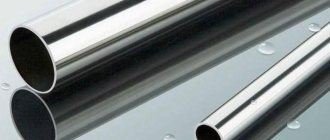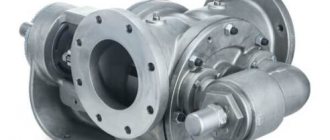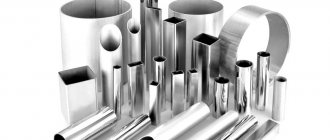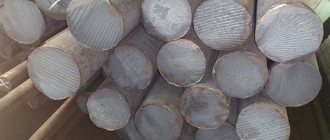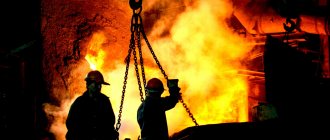AISI 304 stainless steel belongs to one of the most popular 300 series on the Russian market. In an alloy of 17.5% chromium and 8% nickel, these components create a reliable oxide layer on the surface and make the metal non-magnetic. Prefabricated and welded structures, parts of pipelines, and various equipment are made from this material. The characteristics of this rolled metal allow it to be used very widely.
Possible applications:
- containers for transportation and storage of food liquids (milk, beer, wine);
- equipment for food production, public catering organizations;
- kitchen utensils, cutlery;
- heat exchangers;
- couplings, retorts, pipes;
- ventilation systems, chimneys;
- medical equipment;
- decorative elements (external or internal), furniture, architectural details;
- pipes;
- installations in chemical, textile, pharmaceutical, paper factories;
- welded metal structures.
Characteristics and properties of AISI 304 steel
AISI 304 steel is a low-carbon, austenitic, non-hardening, acid-resistant alloy with corrosion resistance. It can be welded well by any method and can be processed cold and hot. Shows high strength at low temperatures, as well as resistance to short-term temperature increases up to 900 ⁰C. Operating temperatures: from –196 to 600 ⁰С in an environment of medium activity.
Chemical composition of AISI 304 steel
Mechanical properties
Corrosion resistance of AISI 304 steel
Features of the chemical composition
Steel 304 is part of the austenitic class of corrosion-resistant steels. Externally, it is easily recognized by its metallic luster and characteristic greenish tint. The steel is an American-made product.
AISI stands for American Iron and Steele Institute, which translates as the Institute of Steel and Iron of America.
The chemical composition is regulated by US government standards. According to them, in addition to the main component of iron, steel should include the following components:
- Carbon – 0.08%. An irreplaceable element of all grades of steel alloys. It is responsible for the ability of steel to be strengthened under the influence of heat treatment. The more it is in the composition, the higher the hardness of the alloy. But an uncontrolled increase in carbon negatively affects the technological characteristics of the material. In particular, ductility and weldability. In AISI 304, the problem is solved by partially replacing carbon with nickel. Thanks to this, the strength of steel increases without affecting its ductility in any way.
- Silicon – up to 1%. The task of silicon, as an alloying element, is to remove dissolved oxygen from the particle, which enters the steel during smelting. Due to this, the percentage of segregation (heterogeneity of the chemical composition) is significantly reduced, which has a positive effect on the mechanical characteristics of the alloy. An increase in strength occurs without a decrease in viscosity and elasticity. This also opens up the possibility of using steel in work under conditions of impact loads.
- Manganese – up to 2%. Its purpose is similar to the element described above. It also belongs to the group of steel deoxidizers. This high percentage of manganese content increases the hardness and wear resistance of AISI 304 without reducing its ductility. Also, the addition of manganese reduces the risk of scale formation during metal operation at elevated temperatures.
- Chrome – 18%. Under the influence of atmospheric gases, chromium particles located on the metal surface are oxidized, thereby forming a wear- and corrosion-resistant layer based on chromium oxides. It significantly increases the resistance of AISI 304 to abrasion on the one hand, and on the other hand makes the alloy more resistant to the formation of various types of corrosion. Chromium also has a beneficial effect on the hardenability of steel. The thickness of the hardened layer when adding this alloying element increases by 20-30%.
- Nickel – 10%. Its presence in the composition makes the steel more durable and corrosion-resistant. Impact resistance also increases in proportion to the increase in nickel in the alloy composition. In addition, nickel increases the effect of alloying with chromium, increasing the thickness of its oxide film.
- Phosphorus – up to 0.045%. Phosphorus has a larger molecular size compared to iron and carbon. Being integrated into the intercrystalline structure, it makes the metal less resistant to mechanical loads, reduces ductility and increases the likelihood of cracks.
- Sulfur – up to 0.03%. Like phosphorus, sulfur belongs to the group of undesirable impurities. It reduces the strength properties of steels and, in addition, significantly increases the risk of scale. Its presence in the alloy is due to technological errors during smelting. Namely, the inaccuracy of the content of certain components of the charge.
Rolled metal from AISI 304 steel
You can buy AISI 304 in a wide range.
Products are offered with different types of surface (matte, polished, mirror, decorative), manufactured in different ways - hot-rolled, cold-rolled. The company's technical consultants will help you choose the right item and guide you through the assortment. We supply:
- flat rolled products;
- long products;
- shaped rolled products;
- electric welded pipes;
- seamless pipes;
- wire;
- forgings;
Stainless steel sheet Aisi 304
Stainless steel roll Aisi 304
Welded stainless steel pipes Aisi 304
Advantages of stainless steel
The main advantages of using stainless steel:
- Products gain strength. They become more reliable and can last for a long time, which is more than ten years.
- Heat resistance. Products can withstand temperature changes and become resistant to high temperatures.
- Products become resistant to any environmental conditions.
- The products are made from environmentally friendly materials.
- The products are attractive in terms of external characteristics.
- The products are not subject to rust or plaque formation.
In general, it can be noted that the use of stainless steel in the production of various types of products is an effective way to obtain high-quality products that can last for many years.
How to determine the properties of stainless steel by markings
Regulatory documents establish the rules by which stainless steel is marked:
- The first number of the name indicates the amount of carbon in the alloy. Example: in steel type 20Х13 – the quantitative indicator of carbon is 0.2%, and in alloy grade 08Х18Т1 – 0.08% carbon.
- The letter represents a chemical element. For example, “M” indicates the presence of manganese, “X” indicates chromium, and “H” indicates nickel. After the letters there are numbers indicating the content of the element in the alloy as a percentage.
Basically, the rules for marking stainless steel do not differ from the generally accepted designations of other types of steel alloys.
Analogues[edit | edit code]
Russian analogues of steel: AISI 304 according to GOST - 08Х18Н10, AISI 304L - 03Х18Н11.
Analogs and names of steel: AISI304, AISI 304, T304, 304 T, SUS304, SS304, 304SS, 304 SS, UNS S30400, AMS 5501, AMS 5513, AMS 5560, AMS 5565, AMS 5566, AMS 5567, AMS 5639, A MS 5697 , ASME SA182, ASME SA194 (8), ASME SA213, ASME SA240, ASME SA249, ASME SA312, ASME SA320 (B8), ASME SA358, ASME SA376, ASME SA403, ASME SA409, ASME SA430, ASME SA479, ASME SA688, ASTM A167, ASTM A182, ASTM A193, ASTM A194, ASTM A666, FED QQ-S-763, Milspec MIL-S-5059, SAE 30304, DIN 1.4301, X5CrNi189, BS 304 S 15, EN 58E, PN 86020 (Poland), OH18N9, ISO 4954 X5CrNi189E, ISO 683 / 13 11, 18-8
Physical and mechanical properties[edit | edit code]
| Characteristic | Meaning | Note |
| Brinell hardness | 123 | |
| Hardness, Knupu | 138 | |
| Hardness, Rockwell B | 70 | |
| Hardness, Vickers | 129 | |
| Tensile strength | 505 MPa | |
| Tensile yield strength | 215 MPa | |
| Plastic | 70% | H 50 mm |
| Elastic modulus | 193 - 200 GPa | |
| Poisson's ratio | 0,29 | |
| Sharpie | 325 J | |
| Shear modulus | 86 GPa | |
| Electrical resistance | 7.2e-005 ohm-cm | at 20 °C; 1.16E-04 at 650 °C |
| Magnetic permeability | 1,008 | at room temperature |
| KTE, linear 20 °C | 17.3 µm/(m K) | |
| KTE, linear 250 °C | 17.8 µm/(m K) | |
| KTE, linear 500° C | 18.7 µm/(m K) | |
| Specific heat | 0.5 kJ/(kg K) | |
| Thermal conductivity | 16.2 W/(mK) | |
| Melting temperature | 1400 - 1455 °C | |
| Solidus | 1400° C | |
| Liquidus | 1455 °C |
This grade of steel is used in the manufacture of prefabricated and welded metal structures, components of pipeline fittings, as well as household equipment. For example, railings for balconies and stairs, kitchen appliances, car exhaust systems. In sheet form, AISI 304 steel is divided into cold-rolled and hot-rolled material, which is determined by the production method. The form of sale of flat metal products is sheets and rolls. The surface of the canvas is determined by the processing method and can be matte, polished, or mirror. AISI 304 sheet is used for the production of electric-welded pipes, cutting equipment, and building structures. It is not subject to corrosion in places of scratches or other mechanical damage. Containers made from it are used for storing and transporting products from the food and chemical industries (weak chemicals). In tube form, AISI 304 stainless steel can have a round, square or rectangular cross-section. According to the production method, pipes are divided into electric-welded and seamless. The appearance of the surface, as in the case of a sheet, depends on the processing method: matte, polished, mirror. AISI 304 steel is used to make barrels for beer and kvass, bellows, chemical equipment, bunkers, cooling coils, cryogenic vessels, dairy equipment, evaporators, cutlery, dishes, pots and pans, equipment for the food industry, medical industry, surgical equipment, needles Hypodermic injections, kitchen sinks, marine equipment and fasteners for nuclear ships, oil well filter screens, refrigeration equipment, paper industry, pressure vessels, plumbing fittings, valves, feed drums, pipes, painting, textile equipment, tanks and containers for a wide variety of liquids and solids, industrial equipment in the mining, chemical, cryogenics, food, dairy and pharmaceutical industries.
Corrosion resistant stainless steel
Stainless steel has the ability to maintain anti-corrosion characteristics only in the presence of oxygen, which promotes the formation of a protective chromium oxide layer (chrome oxide film) on the surface of the stainless steel. This layer is characterized by the ability to insulate the metal surface and prevents the exposure of steel to aggressive substances. The presence of oxygen always leads to self-healing of the layer, but as a result of damage or destruction of the chromium oxide layer, a corrosion process occurs. Corrosion of stainless steel can be of several types.
Crevice corrosion
This corrosion occurs in the gaps between the stainless steel and some material, such as a seal, gaskets, etc. Loose contact or severe surface roughness can lead to the penetration of an aggressive substance into the gaps. We can talk about the limited access of oxygen to such places and the destruction of the protective oxide layer of stainless steel without the possibility of restoration in an independent form. Oxidation of the metal surface will occur under the influence of an aggressive substance, which will lead to the onset of corrosion, which, in turn, will result in rust appearing on the surface, while the stainless steel will further deteriorate. The smoother the surface of the products and the smaller the gap between them, the smaller the risk of crevice corrosion. It can often be observed in fasteners that are used in sea water, the flow speed and lack of oxygen in which can cause acceleration of crevice corrosion processes.
Pitting (pitting) corrosion
The occurrence of this type of corrosion is recorded in the most frequent cases due to damage to the surface of stainless steel, which leads to damage to the protective oxide layer. The result of the interaction between the unprotected stainless steel surface and the environment will be the formation of dark spots or spots. If the first signs of corrosion are not removed, spots of rusty ulcers will form with further surface destruction. In addition, the occurrence of pitting corrosion can be caused by a non-uniform characteristic of the structure of the material or the presence of certain inclusions of other substances in the latter, which can often be found when production technology is violated. This type of corrosion can also be caused by increased porosity of the structure, strong roughness and the presence of scale. The processes of such corrosion will be noticeably accelerated by an increase in temperature indicators.
An important characteristic of any metal is a certain level of its electrical potential. The appearance of a conductive medium between metals leads to the emergence of a current between them, which is determined by the appearance of charged particles from one metal to another. In this case, the slow or rapid destruction of the metal that gives up electrons will be recorded, and the absence of susceptibility to changes in the other metal. This all forms galvanic pairs, which can be acceptable or unacceptable.
In permissible galvanic couples, a reaction of extremely low strength and low speed is recorded; in unacceptable ones, the reaction quickly leads to high-speed destruction of one of the metals. As for stainless steel fasteners, their use is not allowed in structures characterized by the possibility of a galvanic couple with copper and copper alloys. In this case, high-speed formation of rust will be recorded by the surface layers of stainless steel in such a pair.
Another recommendation is to use stainless steel with aluminum, but this only applies to using the two materials in water or wet environments. Due to an increase in temperature, the speed of processes that occur in galvanic couples can be increased, which can result in an aggravation of the corrosion process.
What is the difference between stainless steel and regular steel?
All grades of stainless steel contain chromium (Cr). Chromium changes the structure of the alloy crystal lattice. It becomes cubic. Increases strength and corrosion resistance. A protective film of Cr2O3 oxide forms on the surface.
Stainless steel products are durable. They last longer than galvanized iron containers. They do not rust like regular carbon steel. Their properties:
- Chemical resistance
- Strength, wear resistance
- Good weldability, easy cold processing
- Aesthetic appearance
Fact: Stainless steel was patented in 1913 in England. Equipment for chemical production was made from stainless steel. It has become the best material for food containers. Today, many household items are made from stainless steel. These are kitchen sinks, dishes, knives, countertops, cutlery.
In Russia and the CIS countries, stainless steels are marked according to GOST.
